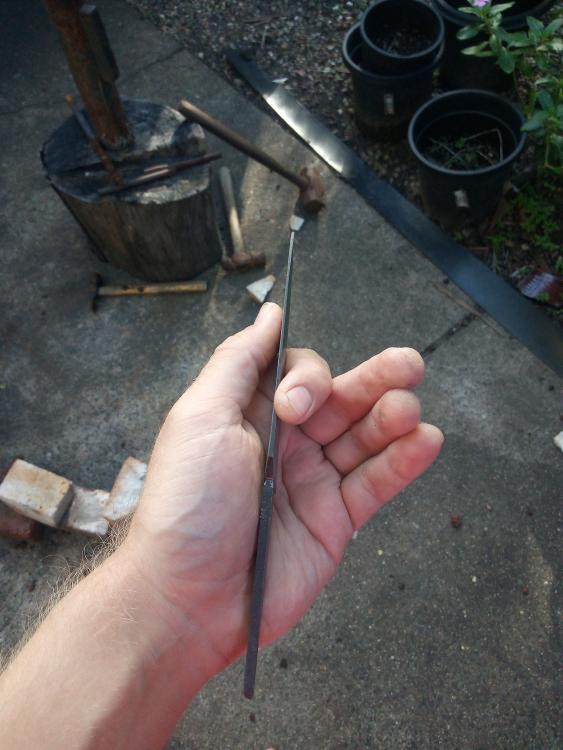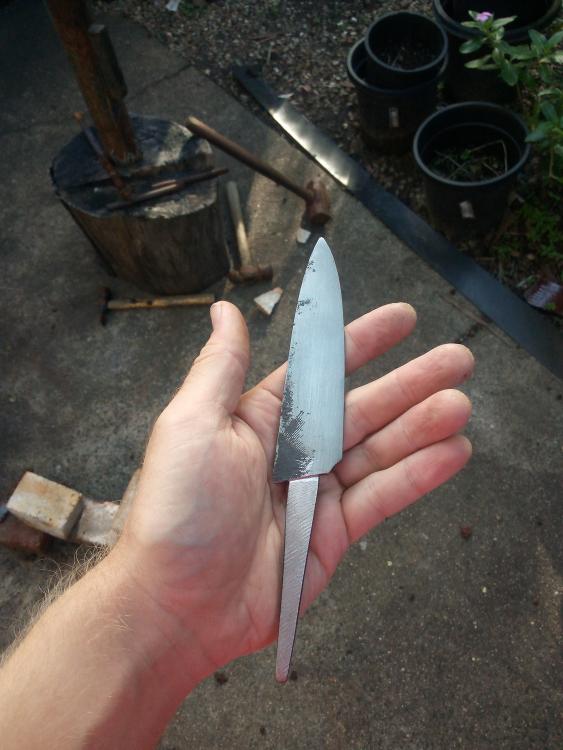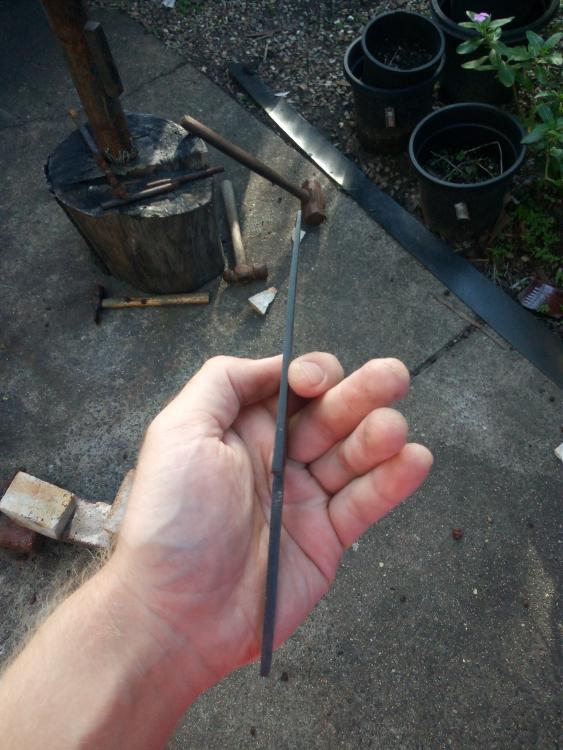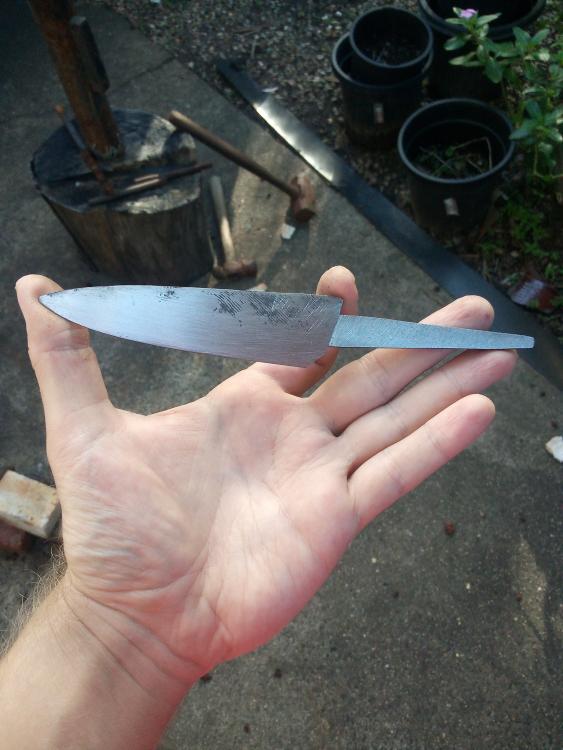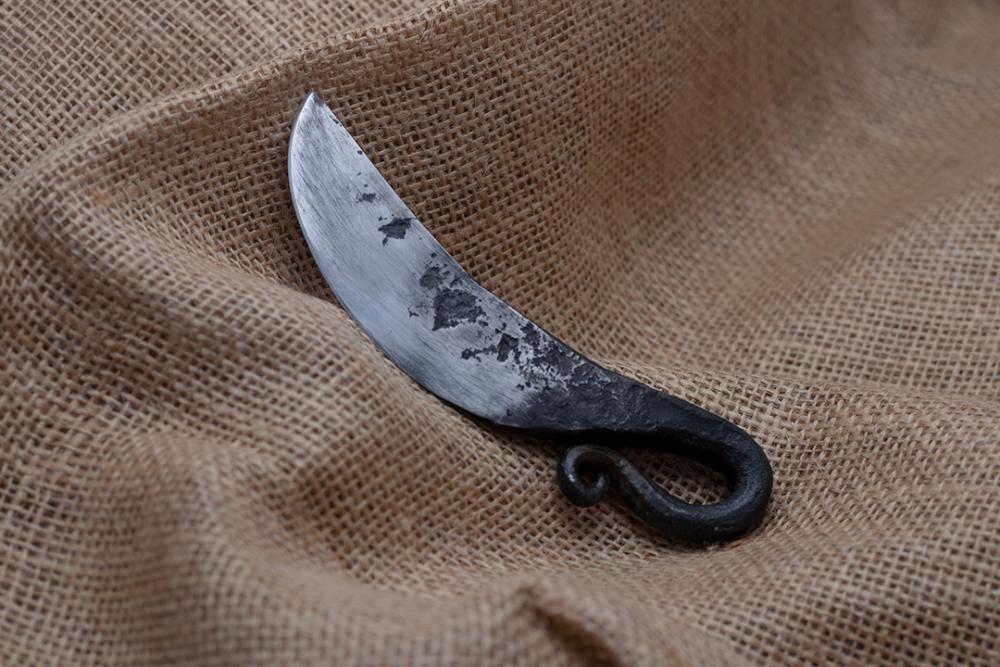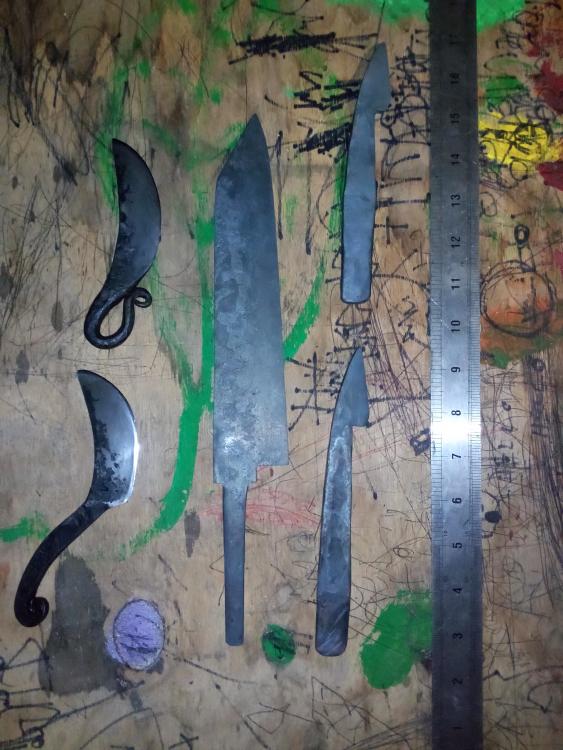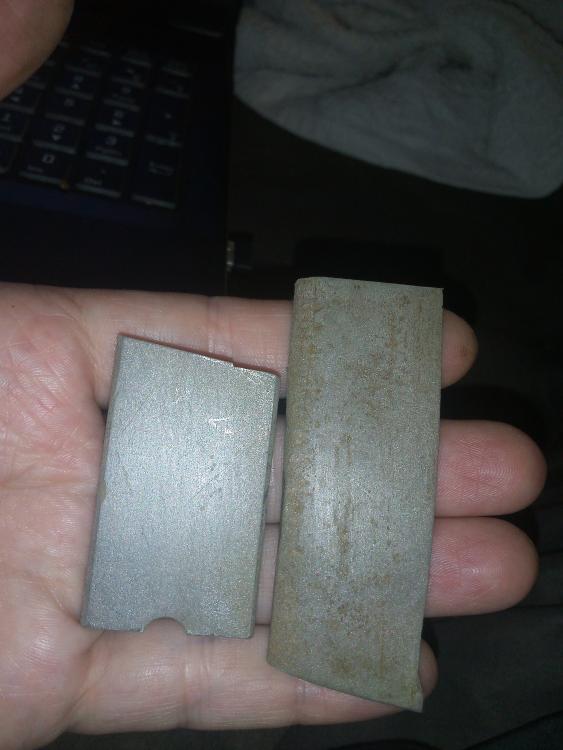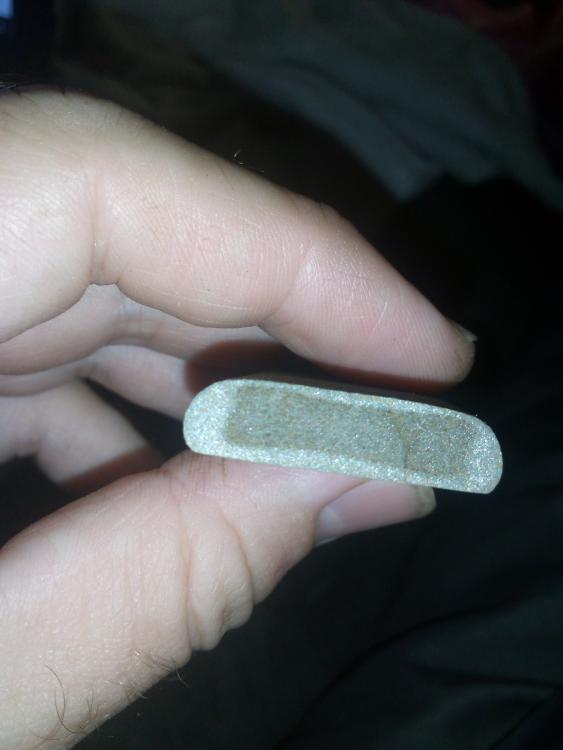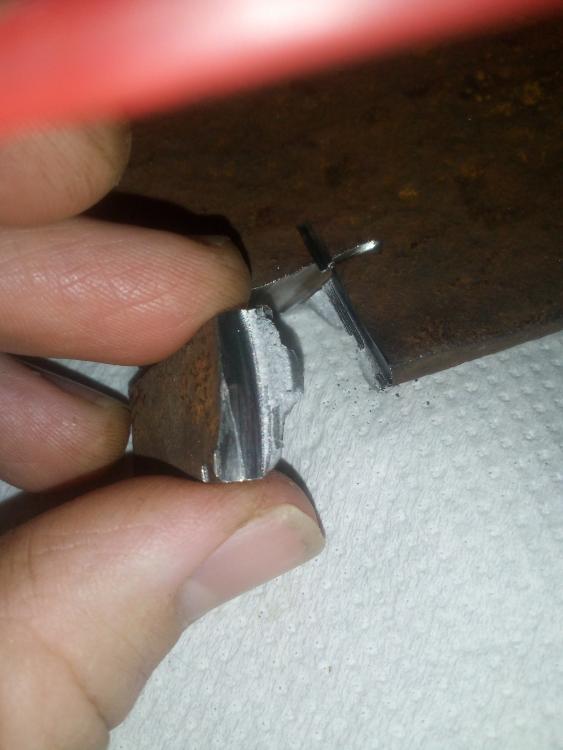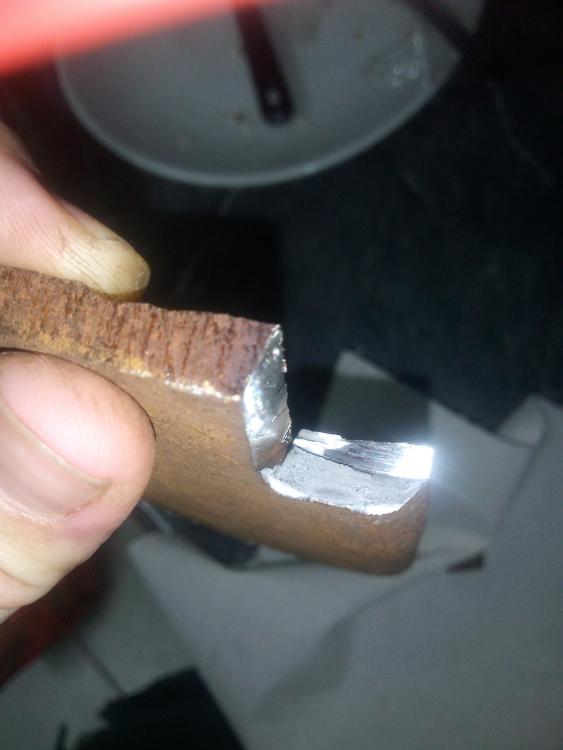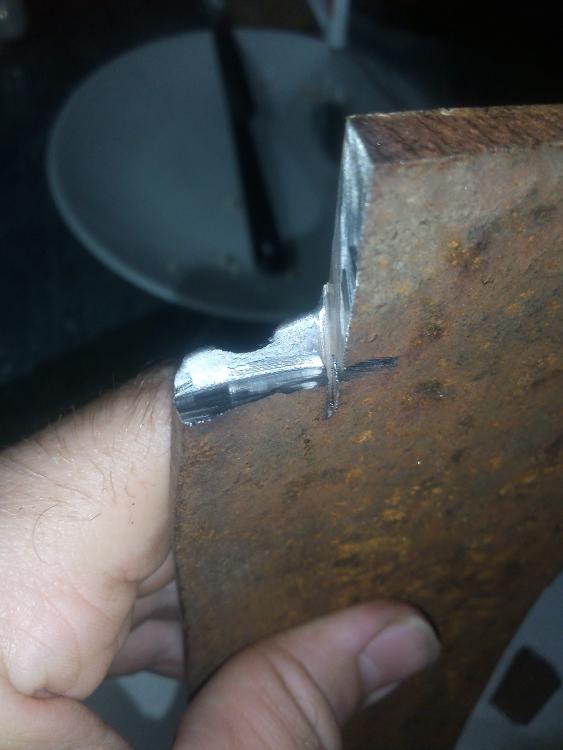
Bonnskij
Members-
Posts
235 -
Joined
-
Last visited
Content Type
Profiles
Forums
Articles
Gallery
Downloads
Events
Everything posted by Bonnskij
-
Bjorn makes sharp things. My beginners log book
Bonnskij replied to Bonnskij's topic in Member Projects
Haha! I might give that a go. I'd rather not end up with loads of toxic waste. Or maybe i can trade toxic waste for less toxic things, like a carton of beer. On that note though, could i simply force rust my spanners? (One of the lesser known Jedi tricks). Also. Working on a file knife for a friend of mine. I've already normalised and thermocycled it five times. Yesterday i noticed the tang was a bit off centre, so i clamped the blade cold in the vise, and gave the tang a couple of wacks and it's straight now. But do i need to redo the normalising? Also the hardening plan is clay the back and go three seconds in brine and then into canola. Good plan or rubbish plan? I'm trying to get a hamon on this knife. -
Bjorn makes sharp things. My beginners log book
Bonnskij replied to Bonnskij's topic in Member Projects
That is certainly something that I didn't find during my sleuthing sessions. Copper would certainly pose a bit of a problem if you were to try to forge it as is I imagine. (I'm assuming the chromium might disassociate anyway but...). Definitely good thinking, and I'd never have thought of it but it looks like the reason chromic acid is used is because a chrome anode does not readily go into solution, so a lead anode (or cathode?) is used instead. I wont pretend to understand it, so I hope someone can set me straight on that one as well. I sure like your attitude to the question. -
Bjorn makes sharp things. My beginners log book
Bonnskij replied to Bonnskij's topic in Member Projects
Thanks Frosty. That does indeed seem to be the case. And yes. I don't know how I would deal with the acid solution afterwards. Can't just neautralise and pour down the sink for that mix I reckon. But there's copper in it? I thought it was just a vanishingly thin layer of chromium on top of Nickel. I tried vinegar (at least I think I did). Didn't seem to do much, but then again. For all I know the chromium could have been stripped away and the nickel could still be there. (The nickel remains shiny right?) I often see it reckommended to grind the plating away, but that seems to be an exceedingly bad idea. It would probably make more airborne chromium particles than if it was forged as is. -
Bjorn makes sharp things. My beginners log book
Bonnskij replied to Bonnskij's topic in Member Projects
Picked up a bunch of spanners on a garage sale that I'm wanting to make hooks with. Mostly chrome plated it would seem. Now I've heard a lot of talk about the dangers of chromium poisoning, hexavalent chromium, chromium fumes and the likes. I have spent a few days reading about the subjects and believe I know how to take reasonable precautions. Crucially: -Coating is most likely trivalent chromium, but readily converts to hexavalent chromium at the highest rate between 200 and 300 degrees celsius. -Hexavalent chromium reduces in the presence of organic material (That would be hoomans, but also many other things). -The vapour pressure of chromium is 1 P at 1656 K. If there is something I might be missing here. Please do let me know. I don't want to play silly buggers with my own or others health. Also, I know I am being a bit vague. I do not wish to provide any advice that could put others in danger should I be mistaken and others choose to follow it. Chemistry and medicine are not my fields of science. -
Bjorn makes sharp things. My beginners log book
Bonnskij replied to Bonnskij's topic in Member Projects
-
Justin’s Smithing progression. [PIC heavy]
Bonnskij replied to Justin Topp's topic in Member Projects
Thanks. Good to know. I've heard higher carbon has more of a ring to it as well, so I was wondering, -
Bjorn makes sharp things. My beginners log book
Bonnskij replied to Bonnskij's topic in Member Projects
400 000 tablets?? I hope it's large font, otherwise I'll be reading for a while. Thanks for the suggestions. Some of the things I've been working on. The old viking knives are finished. I decided to finish those with files and a natural stone, figuring there wasn't much sandpaper around 1000 years ago (I don't know how authentic my finish is, but i'm trying). The stone was a Japanese aka-monzen (I think) and has left a pretty dark patina. The kitchen knife should be just about ready for the quench, but I'll fit the handle first. The kiridashis need a bit more time on the files before going in the quench. -
Justin’s Smithing progression. [PIC heavy]
Bonnskij replied to Justin Topp's topic in Member Projects
Is it mild or another alloy? How's the sound? (I've been wanting to make a triangle for my kids). -
Bjorn makes sharp things. My beginners log book
Bonnskij replied to Bonnskij's topic in Member Projects
I would be very interested in reading about that. That's all very interesting as well. Would that all have survived as oral traditions through thousands of years do you reckon? -
Bjorn makes sharp things. My beginners log book
Bonnskij replied to Bonnskij's topic in Member Projects
For sure. The Australian aboriginal peoples actually have oral traditions detailing the end of the last ice age. Wonder if other cultures have something of the same sort. (I don't think there is any stories older than the First Australians have, but it would be an interesting comparison). For the record, currently reading little bits of Konungs skuggsja, or the Kings mirror/ Speculum regale, and the insights of the author into the workings of the natural world is very fascinating. I guess that's a bit off topic, but thought it worth mentioning. -
Bjorn makes sharp things. My beginners log book
Bonnskij replied to Bonnskij's topic in Member Projects
My library is going to be so great thanks to you guys. Do you have any examples of parallels? Long ago I used to think most ancient peoples hardly knew of each other and had little interaction. But clearly that's not true, so there was probably a lot of sharing of myths as well. -
Bjorn makes sharp things. My beginners log book
Bonnskij replied to Bonnskij's topic in Member Projects
Great! Thanks! -
Walnut oil and hemp oil will also cure when left to their own devices. Walnut oil was favoured for oil paint in the renaissance as it dries clear and yellows less over time.
-
Bjorn makes sharp things. My beginners log book
Bonnskij replied to Bonnskij's topic in Member Projects
It's for sure confusing. I do love it though. Recently read Neil Gaiman's book on Norse mythology and Stephen Fry's book on Greek. Can highly recommend both. It's strange for sure. Judging by the curve it would be the right circumference. It seems rather narrow though. That being said I don't know how narrow wagon wheels could get. It also has a hole in it that seems to be for a bolt of sorts. I don't know if wagon tires ever had that? Could it be from the suspension of a wagon? -
Bjorn makes sharp things. My beginners log book
Bonnskij replied to Bonnskij's topic in Member Projects
Aah I see. I was only able to find a picture of the front page and a few pages from inside the book without any people on them, so I didn't see many faces. I also found a book that was just called "The prune people" and it just left me mighty confused. I have only three known alloys in my steel library. But it's a start! -
Bjorn makes sharp things. My beginners log book
Bonnskij replied to Bonnskij's topic in Member Projects
Well my pieces have come out of the acid bath and... I'm not entirely sure what to make of it. The smallest piece is surely not wrought iron. Unsure about the larger one, but i know i did a poor job of sanding and prepping that one for lack of time. Interestingly the smaller wagon tire appears to be mild steel wrapped around a high carbon core. Anybody have any insights on that? -
Bjorn makes sharp things. My beginners log book
Bonnskij replied to Bonnskij's topic in Member Projects
Didn't manage to find the prune people viking book, but did find the tre tryckare one (Sounds Swedish. In Swedish it would translate to "Three printers" I believe). Looks like a good one. Irondragon: No I can't seem to see any difference between it and steel. The rust pattern is also dimpled rather than the fibrous pattern you'd expect. Thomas: So far I'm doing a pretty poor job of identifying anything based on sparks. This morning I was grinding down a piece of the wagon tyre with a flap disc to prepare for etching and decided to hit a piece of spring steel as well to compare, but couldn't really make out a difference. I have attempted to etch in vinegar, hot vinegar, hot vinegar and salt, apple cider vinegar, coffee and lime juice without much success. I currently have a couple of pieces in a solution of hydrochloric acid out the back, so if that doesn't work I'm out of ideas. -
Bjorn makes sharp things. My beginners log book
Bonnskij replied to Bonnskij's topic in Member Projects
Never heard of the prune people before. Another thing to look up. Interested in your adze for sure! Bought some wrought iron from a Minnesota wagon wheel some time back. Decided to break off a piece today to confirm. I think I've been bamboozled. Anybody more knowledgeable than me care to chime in? -
Bjorn makes sharp things. My beginners log book
Bonnskij replied to Bonnskij's topic in Member Projects
My core interests would be tools, knives and eating implements from Northern Europe. Centred around Scandinavia and England. In England I am mostly interested in the area around York as there has been many foreign occupants and a possible evolution of tools and foreign influence would be interesting to look at. From pre-roman to Roman (eorwik) through to Anglo Saxon (Northumbria) and viking occupation (Jorvik) and a little bit after. Within tools I am particularly interested in ship and boat building tools. The metallurgy and chemical composition of tools would be similarly interesting. -
Bjorn makes sharp things. My beginners log book
Bonnskij replied to Bonnskij's topic in Member Projects
Thank you so much! That is absolutely wonderful! I am an utter history nerd, so I'll read anything on the subject that I can get my hands on. I'll have to make myself a list and systematically start hunting down all these publications. Gonna have to get myself a copy of the mastermyr find too I think. Once again. Thanks heaps friend! -
Bjorn makes sharp things. My beginners log book
Bonnskij replied to Bonnskij's topic in Member Projects
JHCC: Well now i fell silly. I spent so much time thinking about the blade geometry (where I saw no discernable improvement), that I forgot to think about the stregth aspect. I also assumed as soon as a fairly oval shape was made, the twisting was no longer an issue, but then again the lugs on old designs might contradict that. Thomas: I'll have to take a look at modern axe eye designs and compare them I think. It would be interesting to know how much of a difference there is. I am just about to start chapter three in "The sword and the crucible", so far it is is a very fascinating read, and I reckon the bibliography will come in very handy. Will absolutely read this book cover to cover. Other than that I haven't really read any books about ancient metallurgy. That is certainly about to change though! -
Bjorn makes sharp things. My beginners log book
Bonnskij replied to Bonnskij's topic in Member Projects
Thank you for the recommendations Thomas! I'll have to put the first book on my wishlist. That sounds like a great read. I can get an electronic copy of The sword and the crucible from my university, so that will be my first read (thankfully I don't have to pay for that one. I could get seven copies of "Knives and scabbards" for the price...) I probably can't tell perlite from ferrite, but I read dry academic articles (mostly about plankton) quite regularly, so I don't approach it unprepared. Though my primary interest is European blades from around 1000 a.d, I am really interested in other time periods as well, and can't wait to take a deep dive into your book recommendations. It is greatly appreciated! And yes, I don't think I have seen two identical blades from the archaeological records. As an aside I have found myself pondering the evolution of axe eyes way to much. From round to slightly oval makes sense, but there is a gradual thinning and lengthening of the eye throughout the centuries, and i'm not entirely sure why. -
Bjorn makes sharp things. My beginners log book
Bonnskij replied to Bonnskij's topic in Member Projects
Just came across another little tidbit from the archaeological museum that might be interesting. Doesn't come with a photo but describes a curved knife (found 1858. Description from the same time I believe: "kidneyshaped object in iron. Sharp along the outer edge. 8.5cm long, 3.2cm wide, 1.0cm thick". My knife is coming along with a similarly chonky 7mm thickness (distally tapering to zero). Not sure if my interpretation is historically correct though. -
Bjorn makes sharp things. My beginners log book
Bonnskij replied to Bonnskij's topic in Member Projects
My pleasure Frosty! I'm happy you find it interesting. I love archaeology myself, but it can be so hard to find accurate information online. Google seems more like a shop directory these days. I'm glad if i'm able to give back to the community. You're probably right that they're not intended for heavy use. The one i'm working on feels comfortable, but almost like a pocket knife. Small and easy to reach for to do minor tasks. I wish there was more information available that could narrow down the use for the knives a bit though. I never find information on the weight or photos from the back or front to show the edge geometry. More information on the chemical composition could also be useful. It is always listed as made from iron, but on unimusportalen there's even antique sabers listed as being made from iron, and i don't believe that. Are they actually iron? Are they steel? Do any of them have a forge welded edge? I have been trying to find out more about what was found along with the knives that were gravefinds, but have reached a dead end. I might try to contact the museum. Hopefully they're accommodating. Bit much belly for my taste too. I saw someone on youtube suggest they were kitchen knives, but i feel that other period knives such as large seaxes or belt knives would be better for that. Archaeology and ancient history is an absolutely fascinating subject! I hope George finds something fascinating as well, and i will continue digging myself on my end. Looking through the catalogues of archaeological finds, i feel that archaeologists could benefit from insights from blacksmiths, hunters, tradies and the general public really. I see that the seax of beagnoth is officially a high status weapon and the runes are implied to have magical qualities. Someone on Tod's workshops channel on youtube suggested however that it was the final test of an apprentice smith, and i love that theory! Personally i am much more interested in every day tools and utility knives from ancient times than i am in weapons, but it seems to be much harder to find information on the former than the latter. -
Bjorn makes sharp things. My beginners log book
Bonnskij replied to Bonnskij's topic in Member Projects
Haha! That is quite possible.
